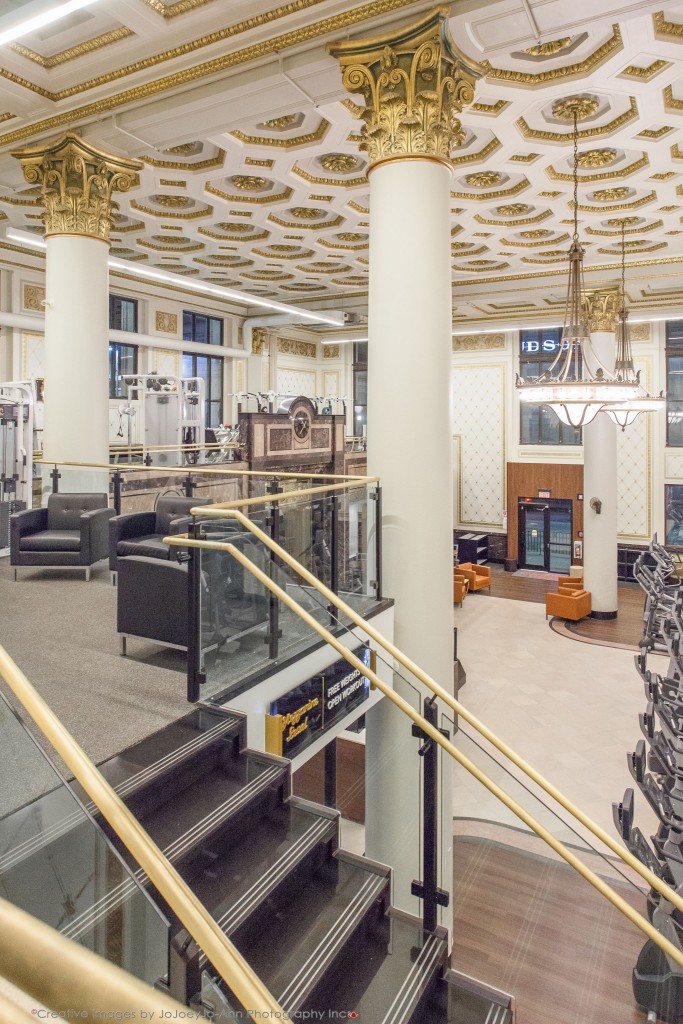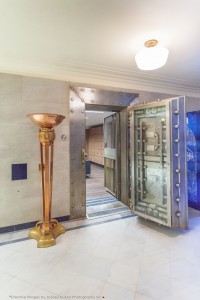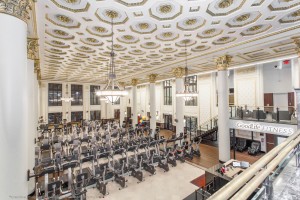The Right Restoration Fit: Balancing heritage requirements with modern fitness club amenities

All photos © CiJJJ Photography
In the middle of downtown Calgary, the former Bank of Montreal (BMO) building on Stephen Avenue has been given a new life as a GoodLife Fitness centre.
Originally built in 1931, the well-known landmark is supported by Corinthian columns and clad in Manitoba Tyndall limestone and was one of the first bank offices in the country. Its Neoclassical style boasts inlaid marble floors and walls, ornate brass handrails and doors, and lavish gilded plasterwork. Once the home of well-known Calgary music store A&B Sound, it had been vacant for a decade.
With more than 330 fitness clubs across Canada, GoodLife Fitness is constantly expanding and Calgary is one of its target locations. There are already 15 clubs in the city, but founder and CEO David ‘Patch’ Patchell-Evans was searching for the right place to open a flagship downtown club. He recognized the potential of the Stephen Avenue BMO location and the importance of preserving this vital part of Calgary’s heritage—a building symbolizing the origins of the city’s business success.
“Calgary has such a successful economy and vibrant business core,” said Patchell-Evans. “This gorgeous building pays tribute to the city’s heritage and provides an opportunity to bring a truly unique, enjoyable fitness experience to people working and living downtown. This was very different from our typical location, but when I walked through the door, I knew it was the one.”
The GoodLife Fitness design and construction team visualized the possibilities and committed to open a flagship downtown club in the old building. The first step was to restore the structure.
Club designer Lori Ireland of Square Feet Design Group Inc., worked alongside Jeff van Haeren, GoodLife’s director of construction, and Trigon Construction Management to develop plans for the transformation from a 1930s bank to a modern fitness club. This project was unlike the hundreds of previous clubs the team had developed. The Stephen Avenue BMO building offered new opportunities, but also new challenges because of its heritage status.

“As you can imagine, the design process for this location was more challenging than usual,” explained Ireland. “We had to think well outside the box because of the structure and mostly the heritage nature of the building. We applied the planning standards that all clubs get, but this time with a twist.”
The BMO building had many attributes that proved to be significant design and construction considerations. The building’s ground level and mezzanine are 10.6 m (35 ft) tall, complete with columns topped with ornate Corinthian capitals and decorated with gold gilt appliqué. The original chandeliers are intact and operational large solid brass wall sconces were retrofit with light-emitting diode (LED) lamps to improve lighting levels.
The inside walls are adorned with hand-painted Neoclassic panels with decorative mouldings, and the banking hall’s centre has a solid marble floor with inlaid borders. The floor had been covered for many years, but has since been buffed and polished. The original solid marble stairs were also uncovered and restored to reveal an inlaid marble pattern.
Since the original stairs to the mezzanine had been removed, GoodLife installed a granite and glass staircase in a new location that is now a prominent design feature. The original solid marble handrail and spindles were protected from damage during construction, and the GoodLife team developed custom, hand-painted wood spindles and handrails to replace a section that was previously damaged. The ornate brass handrails were also carefully polished and reinstalled.
The entrance vestibule is made of solid brass slabs, which were buffed and polished to remove tarnish accumulating over the years. The original entry—a revolving door system—had been removed by a previous tenant, but GoodLife installed new exterior full-height glass doors, as well as an interior vestibule.
The main entrance boasts a large marble feature wall with a clock and the original BMO coat of arms. The clock was repaired and the crest was hand-polished. The original bank manager’s office is clad with restored detailed wood wall panels and a marble fireplace and mantel. An existing exposed stone exterior wall in the stationary bicycling room has been showcased with accent lighting.

Van Haeren says the team worked closely with the Historic Resources and Management Branch of the Alberta Ministry of Culture and Tourism to maintain the property’s history and character. Meanwhile, they were tasked with having to strengthen and expand the infrastructure of the building for a fitness club. The construction team reinforced the floor’s structural capacity to carry the weight and vibration of the fitness equipment and redesigned the cooling and fresh air systems to provide more air and better circulation. In the process, solid marble inlaid floors were uncovered and cleaned, ornamental plasterwork was restored, and brass doors and handrails were polished.
From the initial site visit to completion took almost three years. According to van Haeren, the main stages were planning, research, and building modernization to meet the fitness facility’s requirements.
“We developed new approaches to meet infrastructure requirements and ensure the heritage elements of the building would be conserved,” he said. “The construction team took great care to rebuild many of the interior historic features and uncovered beautiful decorative elements in the process. One of the washrooms is actually built inside an old bank vault.”







